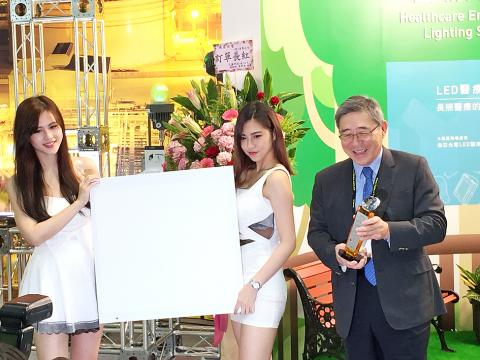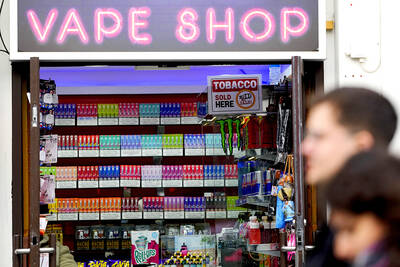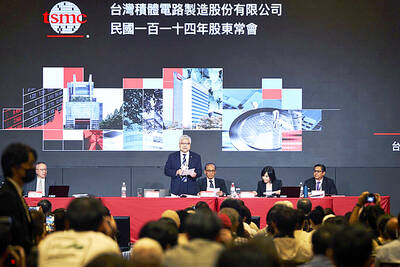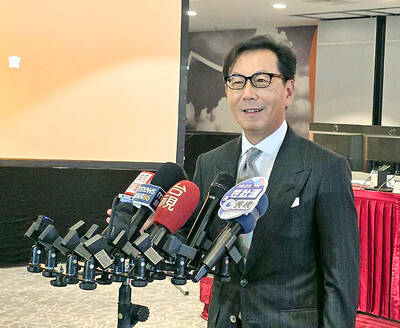LED chipmaker Nan Ya Photonics Inc (南亞光電) yesterday unveiled its new lighting technologies for industrial and medical use — described as an alternative to natural sunlight — in a bid to tap into high-end applications.
With society classified as aging bringing increased demand for long-term care of elderly people, the company hopes its LED UFO Intelight and panel lighting application can make a mark in the local healthcare market.
The company, a joint venture between Nan Ya Plastics Corp (南亞塑膠) and Epistar Corp (晶元光電), said the new application aims to provide an alternative to sunshine for elderly people.

Photo: CNA
“Long-term care is becoming more of an issue for Taiwanese and the government. Some research institutes have indicated that sunshine could be good for elderly people and those with Parkinson’s or Alzheimers,” Nan Ya chairman Wilfred Wang (王文潮) said at the Taiwan International Lighting Show at the Nangang Exhibition Hall in Taipei.
The Taoyuan Chang Gung Memorial Hospital Dementia Center, which is to begin operations this quarter, is to use Nan Ya Photonics’ LED products to simulate daylight and help treat symptoms of dementia.
The company said it hopes the technology can help relieve the burden on family members, as some behaviors of dementia patients bring stress upon their relatives who take care of them.
The application won a prize for innovation at the LED Taiwan exhibition — part of the Nangang lighting show.
At the show, Nan Ya Photonics also presented several flameproof lighting products available for use in hazardous areas.
For instance, the products can be used in Nan Ya Plastics factories and by other firms in the petrochemical industry, the company said.
“Our flameproof lights have several benefits, such as long life, safety and ease of repair because of their lightweight design,” vice president Jung-huang Lo (羅榮晃) said.
The company sells the products in the US market, Lo said.
Other products in the company’s exhibit include display lighting and intelligent video surveillance.
A French electricity company is using the latter, Nan Ya Photonics said.
Nan Ya Photonics, which was established in December 2003, has shifted its business focus to light bulb manufacturing and LED lighting solutions following the shutdown of its upstream epitaxial die division in February.
The company said last year that it would bank on its experience in the lighting business to provide total lighting solutions to clients.
Wang said Nan Ya Photonics aims to provide lighting solutions to diverse industries and sectors.
“It is not just about price competition, good quality is what we strive for,” Wang said. “Lighting solutions are expected to be a great help in the healthcare sector and industrial environments.”
The company hopes higher contribution from lighting applications can help offset losses in the LED upper-stream and middle-stream businesses, Lo said, adding that the company aims to provide full services ranging from lighting design to system configuration in the second half of this year.
The company is striving to turn around its core lighting business this year and hopefully see a substantial growth in revenue next year, he said.

CAUTIOUS RECOVERY: While the manufacturing sector returned to growth amid the US-China trade truce, firms remain wary as uncertainty clouds the outlook, the CIER said The local manufacturing sector returned to expansion last month, as the official purchasing managers’ index (PMI) rose 2.1 points to 51.0, driven by a temporary easing in US-China trade tensions, the Chung-Hua Institution for Economic Research (CIER, 中華經濟研究院) said yesterday. The PMI gauges the health of the manufacturing industry, with readings above 50 indicating expansion and those below 50 signaling contraction. “Firms are not as pessimistic as they were in April, but they remain far from optimistic,” CIER president Lien Hsien-ming (連賢明) said at a news conference. The full impact of US tariff decisions is unlikely to become clear until later this month

Popular vape brands such as Geek Bar might get more expensive in the US — if you can find them at all. Shipments of vapes from China to the US ground to a near halt last month from a year ago, official data showed, hit by US President Donald Trump’s tariffs and a crackdown on unauthorized e-cigarettes in the world’s biggest market for smoking alternatives. That includes Geek Bar, a brand of flavored vapes that is not authorized to sell in the US, but which had been widely available due to porous import controls. One retailer, who asked not to be named, because

CHIP DUTIES: TSMC said it voiced its concerns to Washington about tariffs, telling the US commerce department that it wants ‘fair treatment’ to protect its competitiveness Taiwan Semiconductor Manufacturing Co (TSMC, 台積電) yesterday reiterated robust business prospects for this year as strong artificial intelligence (AI) chip demand from Nvidia Corp and other customers would absorb the impacts of US tariffs. “The impact of tariffs would be indirect, as the custom tax is the importers’ responsibility, not the exporters,” TSMC chairman and chief executive officer C.C. Wei (魏哲家) said at the chipmaker’s annual shareholders’ meeting in Hsinchu City. TSMC’s business could be affected if people become reluctant to buy electronics due to inflated prices, Wei said. In addition, the chipmaker has voiced its concern to the US Department of Commerce

STILL LOADED: Last year’s richest person, Quanta Computer Inc chairman Barry Lam, dropped to second place despite an 8 percent increase in his wealth to US$12.6 billion Staff writer, with CNA Daniel Tsai (蔡明忠) and Richard Tsai (蔡明興), the brothers who run Fubon Group (富邦集團), topped the Forbes list of Taiwan’s 50 richest people this year, released on Wednesday in New York. The magazine said that a stronger New Taiwan dollar pushed the combined wealth of Taiwan’s 50 richest people up 13 percent, from US$174 billion to US$197 billion, with 36 of the people on the list seeing their wealth increase. That came as Taiwan’s economy grew 4.6 percent last year, its fastest pace in three years, driven by the strong performance of the semiconductor industry, the magazine said. The Tsai